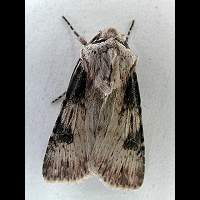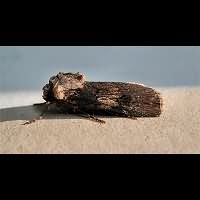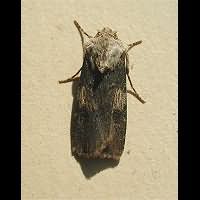Shuttle-shaped Dart Agrotis puta
The Shuttle-shaped Dart is small compared to most other darts in the Agrotis genus. There is a considerable difference between males and females. The male has light wings with dark markings, as can be seen in the top pictures. The circular spot is light too and often hard to see and sometimes invisible. The kidney spot however is dark and clearly stands out clearly. In females this is reversed, as depicted in the bottom photographs. She has dark wings. Her kidney spot is dark too and hardly visible. Her round spot however is light and strikingly present. By the way: the round spot looks like an oval, which has been pulled into two directions. Even though few moths are rather similar in wing markings, none of those has the striking light grey hairs on the thorax. The wing span of the Shuttle-shaped Dart varies little from 30 to 33mm.
The eggs are being laid from April onwards in big groups on leaves of the food plants. The Shuttle-shaped Dart flies in two and probably even three generations a year. And because the species overwinters being a larva, the caterpillars can be found all year long. During the night the caterpillars can be seen feeding on the host plant. During the night they rest in a little hole in the ground. The same hole is used to pupate in. This happens in a light cocoon and takes some three to four weeks only. The caterpillar is of an undefined kind of brown. It has a vague, grey dorsal line. Several faint lines are found on both sides. The head is brown showing small black markings. It is extremely similar to the caterpillar of the Heart and Dart. The behaviour of the caterpillar of the Shuttle-shaped Dart differs from that of most other Agrotis species. While most eat the roots of the foodplants, this species feeds on the leaves.It prefers low growing plants and loves dandelions and dock, but other plants are eaten too and the caterpillar is occassionally found on lettuce. It reaches a length of 30 to 34mm once full grown.
Because the broods of the Shuttle-Shaped Dart are overlapping, the species is on the wing for a long time indeed. The first are seen in April, the last are on the wing in October. It flies by night only, but happily visits flowers in gardens. This species is, like many other Agrotis species, extremely interested in Buddleija. Both male and female are attracted to light and sugar. It is a good model for photographers during the day and may even be manipulated up to a certain extend. This species loves open territories, including roughs, light forests, parks and gardens. Widespread and common in Wales and the southern half of England. Extremely rare in Ireland. No records from northern England, nor from Scotland. Very common on the continent, except for northern parts.
The Shuttle-shaped Dart is small compared to most other darts in the Agrotis genus. There is a considerable difference between males and females. The male has light wings with dark markings, as can be seen in the top pictures. The circular spot is light too and often hard to see and sometimes invisible. The kidney spot however is dark and clearly stands out clearly. In females this is reversed, as depicted in the bottom photographs. She has dark wings. Her kidney spot is dark too and hardly visible. Her round spot however is light and strikingly present. By the way: the round spot looks like an oval, which has been pulled into two directions. Even though few moths are rather similar in wing markings, none of those has the striking light grey hairs on the thorax. The wing span of the Shuttle-shaped Dart varies little from 30 to 33mm.
The eggs are being laid from April onwards in big groups on leaves of the food plants. The Shuttle-shaped Dart flies in two and probably even three generations a year. And because the species overwinters being a larva, the caterpillars can be found all year long. During the night the caterpillars can be seen feeding on the host plant. During the night they rest in a little hole in the ground. The same hole is used to pupate in. This happens in a light cocoon and takes some three to four weeks only. The caterpillar is of an undefined kind of brown. It has a vague, grey dorsal line. Several faint lines are found on both sides. The head is brown showing small black markings. It is extremely similar to the caterpillar of the Heart and Dart. The behaviour of the caterpillar of the Shuttle-shaped Dart differs from that of most other Agrotis species. While most eat the roots of the foodplants, this species feeds on the leaves.It prefers low growing plants and loves dandelions and dock, but other plants are eaten too and the caterpillar is occassionally found on lettuce. It reaches a length of 30 to 34mm once full grown.
Because the broods of the Shuttle-Shaped Dart are overlapping, the species is on the wing for a long time indeed. The first are seen in April, the last are on the wing in October. It flies by night only, but happily visits flowers in gardens. This species is, like many other Agrotis species, extremely interested in Buddleija. Both male and female are attracted to light and sugar. It is a good model for photographers during the day and may even be manipulated up to a certain extend. This species loves open territories, including roughs, light forests, parks and gardens. Widespread and common in Wales and the southern half of England. Extremely rare in Ireland. No records from northern England, nor from Scotland. Very common on the continent, except for northern parts.








